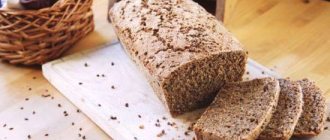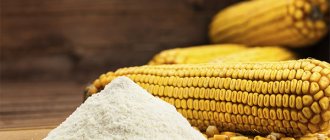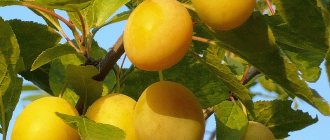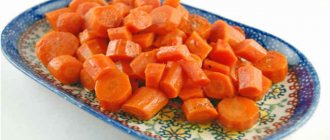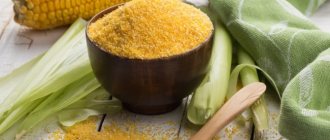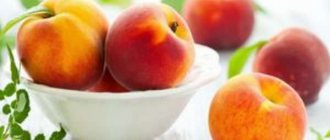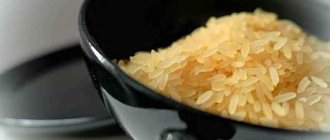What it is
What the product is obtained from is clear from the name. Corn kernels are initially soaked in sulfuric acid . The procedure is necessary to dissolve proteins. Next, after removing the embryo, the grain is crushed. In the process of such processing, milk is obtained, which, when dried, turns into starch.
The product has high energy value. One hundred grams of starch contains more than three hundred kilocalories. The powder contains:
- Vitamins, most of all PP.
- Microelements, most of all sodium.
- Carbohydrates and small amounts of proteins and fats.
There are two types of corn starch used - plain and modified . The first is obtained in the usual way. If simple starch is subjected to additional processing, it becomes modified. This substance has some other characteristics. The modified product has a different smell and color, and may not dissolve in cold water.
Cornstarch Pie Recipe. Calorie, chemical composition and nutritional value.
Nutritional value and chemical composition of Corn Starch Cake.
The table shows the nutritional content (calories, proteins, fats, carbohydrates, vitamins and minerals) per 100 grams of edible portion.
| Nutrient | Quantity | Norm** | % of the norm in 100 g | % of the norm in 100 kcal | 100% normal |
| Calorie content | 145.4 kcal | 1684 kcal | 8.6% | 5.9% | 1158 g |
| Squirrels | 13.4 g | 76 g | 17.6% | 12.1% | 567 g |
| Fats | 2.3 g | 56 g | 4.1% | 2.8% | 2435 g |
| Carbohydrates | 17.6 g | 219 g | 8% | 5.5% | 1244 g |
| Organic acids | 0.1 g | ~ | |||
| Alimentary fiber | 0.6 g | 20 g | 3% | 2.1% | 3333 g |
| Water | 66 g | 2273 g | 2.9% | 2% | 3444 g |
| Ash | 0.305 g | ~ | |||
| Vitamins | |||||
| Vitamin A, RE | 45.6 mcg | 900 mcg | 5.1% | 3.5% | 1974 |
| Retinol | 0.048 mg | ~ | |||
| beta carotene | 0.016 mg | 5 mg | 0.3% | 0.2% | 31250 g |
| Vitamin B1, thiamine | 0.016 mg | 1.5 mg | 1.1% | 0.8% | 9375 g |
| Vitamin B2, riboflavin | 0.087 mg | 1.8 mg | 4.8% | 3.3% | 2069 g |
| Vitamin B4, choline | 44.72 mg | 500 mg | 8.9% | 6.1% | 1118 g |
| Vitamin B5, pantothenic | 0.258 mg | 5 mg | 5.2% | 3.6% | 1938 |
| Vitamin B6, pyridoxine | 0.035 mg | 2 mg | 1.8% | 1.2% | 5714 g |
| Vitamin B9, folates | 1.254 mcg | 400 mcg | 0.3% | 0.2% | 31898 g |
| Vitamin B12, cobalamin | 0.095 mcg | 3 mcg | 3.2% | 2.2% | 3158 g |
| Vitamin C, ascorbic acid | 0.77 mg | 90 mg | 0.9% | 0.6% | 11688 g |
| Vitamin D, calciferol | 0.386 mcg | 10 mcg | 3.9% | 2.7% | 2591 g |
| Vitamin E, alpha tocopherol, TE | 0.139 mg | 15 mg | 0.9% | 0.6% | 10791 g |
| Vitamin H, biotin | 3.756 mcg | 50 mcg | 7.5% | 5.2% | 1331 g |
| Vitamin K, phylloquinone | 0.4 mcg | 120 mcg | 0.3% | 0.2% | 30000 g |
| Vitamin RR, NE | 0.6804 mg | 20 mg | 3.4% | 2.3% | 2939 g |
| Niacin | 0.083 mg | ~ | |||
| Macronutrients | |||||
| Potassium, K | 74.68 mg | 2500 mg | 3% | 2.1% | 3348 g |
| Calcium, Ca | 16.17 mg | 1000 mg | 1.6% | 1.1% | 6184 g |
| Silicon, Si | 0.332 mg | 30 mg | 1.1% | 0.8% | 9036 g |
| Magnesium, Mg | 3.96 mg | 400 mg | 1% | 0.7% | 10101 g |
| Sodium, Na | 34.78 mg | 1300 mg | 2.7% | 1.9% | 3738 g |
| Sera, S | 33.57 mg | 1000 mg | 3.4% | 2.3% | 2979 g |
| Phosphorus, Ph | 41.6 mg | 800 mg | 5.2% | 3.6% | 1923 |
| Chlorine, Cl | 30.13 mg | 2300 mg | 1.3% | 0.9% | 7634 g |
| Microelements | |||||
| Aluminium, Al | 18.2 mcg | ~ | |||
| Bor, B | 40.6 mcg | ~ | |||
| Vanadium, V | 0.66 mcg | ~ | |||
| Iron, Fe | 0.916 mg | 18 mg | 5.1% | 3.5% | 1965 |
| Yod, I | 3.54 mcg | 150 mcg | 2.4% | 1.7% | 4237 g |
| Cobalt, Co | 2.075 mcg | 10 mcg | 20.8% | 14.3% | 482 g |
| Lithium, Li | 0.133 mcg | ~ | |||
| Manganese, Mn | 0.0217 mg | 2 mg | 1.1% | 0.8% | 9217 g |
| Copper, Cu | 42.86 mcg | 1000 mcg | 4.3% | 3% | 2333 g |
| Molybdenum, Mo | 2.141 mcg | 70 mcg | 3.1% | 2.1% | 3270 g |
| Nickel, Ni | 2.82 mcg | ~ | |||
| Rubidium, Rb | 10.5 mcg | ~ | |||
| Selenium, Se | 6.003 mcg | 55 mcg | 10.9% | 7.5% | 916 g |
| Strontium, Sr | 0.56 mcg | ~ | |||
| Fluorine, F | 11.83 mcg | 4000 mcg | 0.3% | 0.2% | 33812 g |
| Chromium, Cr | 1.43 mcg | 50 mcg | 2.9% | 2% | 3497 g |
| Zinc, Zn | 0.2475 mg | 12 mg | 2.1% | 1.4% | 4848 g |
| Zirconium, Zr | 0.5 mcg | ~ | |||
| Digestible carbohydrates | |||||
| Starch and dextrins | 13.296 g | ~ | |||
| Mono- and disaccharides (sugars) | 1.6 g | max 100 g | |||
| Glucose (dextrose) | 0.386 g | ~ | |||
| Sucrose | 0.289 g | ~ | |||
| Fructose | 1.061 g | ~ | |||
| Essential amino acids | 0.017 g | ~ | |||
| Arginine* | 0.153 g | ~ | |||
| Valin | 0.149 g | ~ | |||
| Histidine* | 0.066 g | ~ | |||
| Isoleucine | 0.117 g | ~ | |||
| Leucine | 0.21 g | ~ | |||
| Lysine | 0.175 g | ~ | |||
| Methionine | 0.081 g | ~ | |||
| Methionine + Cysteine | 0.139 g | ~ | |||
| Threonine | 0.119 g | ~ | |||
| Tryptophan | 0.039 g | ~ | |||
| Phenylalanine | 0.126 g | ~ | |||
| Phenylalanine+Tyrosine | 0.22 g | ~ | |||
| Nonessential amino acids | 0.04 g | ~ | |||
| Alanin | 0.139 g | ~ | |||
| Aspartic acid | 0.25 g | ~ | |||
| Glycine | 0.083 g | ~ | |||
| Glutamic acid | 0.346 g | ~ | |||
| Proline | 0.079 g | ~ | |||
| Serin | 0.181 g | ~ | |||
| Tyrosine | 0.093 g | ~ | |||
| Cysteine | 0.056 g | ~ | |||
| Sterols (sterols) | |||||
| Cholesterol | 100.13 mg | max 300 mg | |||
| Saturated fatty acids | |||||
| Saturated fatty acids | 0.6 g | max 18.7 g | |||
| 14:0 Miristinovaya | 0.008 g | ~ | |||
| 15:0 Pentadecane | 0.002 g | ~ | |||
| 16:0 Palmitinaya | 0.391 g | ~ | |||
| 17:0 Margarine | 0.006 g | ~ | |||
| 18:0 Stearic | 0.168 g | ~ | |||
| 20:0 Arakhinovaya | 0.006 g | ~ | |||
| Monounsaturated fatty acids | 0.873 g | min 16.8 g | 5.2% | 3.6% | |
| 16:1 Palmitoleic | 0.074 g | ~ | |||
| 17:1 Heptadecene | 0.002 g | ~ | |||
| 18:1 Oleic (omega-9) | 0.781 g | ~ | |||
| 20:1 Gadoleic (omega-9) | 0.008 g | ~ | |||
| Polyunsaturated fatty acids | 0.221 g | from 11.2 to 20.6 g | 2% | 1.4% | |
| 18:2 Linolevaya | 0.21 g | ~ | |||
| 18:3 Linolenic | 0.011 g | ~ | |||
| 20:4 Arachidonic | 0.019 g | ~ | |||
| Omega-6 fatty acids | 0.3 g | from 4.7 to 16.8 g | 6.4% | 4.4% |
The energy value of Corn Starch Pie is 145.4 kcal.
- Serving = 127 g (184.7 kcal)
Primary Source: Created in the application by the user. Read more.
** This table shows the average levels of vitamins and minerals for an adult. If you want to know the norms taking into account your gender, age and other factors, then use the “My Healthy Diet” application.
Beneficial features
Corn starch is a substitute for traditional potato starch. Both products are similar in their characteristics and method of use. In terms of the beneficial properties of the product for the body, doctors highlight the following:
- Daily use of the substance in question in small doses improves the nutrition of the cells of the nervous system . It also helps in building muscle mass.
- The substances that make up starch accelerate the removal of toxins and waste from the body .
- The powder is recommended for use for patients with diagnosed diabetes mellitus. It helps maintain blood glucose levels within the desired range.
- Helps improve the condition of blood vessels and normalize the process of blood clotting. These properties will be useful for patients with hypertension, anemia and problems with the cardiovascular system.
- Another useful property is that it accelerates the choleretic process . Drinks and decoctions are made from corn starch and are used for urolithiasis.
- A beneficial effect on the functioning of the human immune system has also been noticed . The body's protection from external dangers increases.
Cornstarch does not contain gluten . For this reason, it is often used as a dietary product. Even entire systems have been developed where the main ingredient is starch from corn.
The powder is actively used in cosmetology . It has absorbent properties, which allows the starch to be used in deodorants and powders. The product also allows you to improve the functioning of the sebaceous glands, removes oily shine and has a beneficial effect on the condition of the skin. Various masks, creams and even shampoos are made from corn starch. Many of these recipes are easy to use at home.
What is harmful about corn starch?
Unfortunately, although corn starch is significantly different from the grains of the plant itself, if you are allergic to corn, you have to avoid it too.
If consumed in excess, the positive quality of corn starch - acceleration of metabolism, can be replaced by negative consequences in the form of a slowdown in metabolism in general, and also lead to impaired water metabolism, including dehydration of the body.
Corn starch will definitely be harmful to people with increased blood clotting, since it can further enhance this feature.
Be sure to give up starch in case of serious disorders in the gastrointestinal tract, for example, during exacerbation of gastritis, and for periods when the state of health is almost normal, so that there is no harm from corn starch, the consumption of products containing it is simply reduced to a minimum.
Also, it is recommended to reduce the rate of its consumption by two to three times - to 100-150 g per day for diabetes and pancreatitis - there will be no obvious harm from corn starch in these diseases, but still it is not very easily digestible and does not create anything excess load on the pancreas.
Harm
The use of any product must be carried out according to the rules. If they are violated, then even the most beneficial substance can have harmful consequences for the body. If we talk about the possible harm from using corn starch, doctors give the following list:
- First of all – individual intolerance . Allergies to corn and corn products are rare, but you should always be aware of them.
- Although the substance in question is used in some diets, it still has high energy value . It is not recommended to use it if you are overweight.
- Some diseases of the gastrointestinal tract are contraindications for use. peptic ulcers and gastritis as such .
- The substance in question helps improve blood clotting. If a person has thrombophlebitis , then the use of the product should be completely abandoned.
Particular attention should be paid to quality. In the modern world, unacceptable amounts of pesticides are used in agriculture to obtain large yields.
In addition, the cultivation of genetically modified plants has become widespread. What is more harmful or beneficial from corn obtained in this way is unknown. It is better to give preference to a product obtained using traditional methods.
Corn starch - benefits and harms
Corn starch is a product obtained from corn grains, has a milky-white color with a yellowish tint and a characteristic odor. This product dissolves well in both cold and hot water, and due to the swelling properties of corn starch, it is widely used in food preparation, both at home and in factories, as a thickener.
Recently, adherents of a healthy diet have been agitating to give up starchy foods. However, in order to judge the benefits and harms of corn starch, you should understand its properties, as well as indications and contraindications for use.
The benefits of corn starch
Starch made from corn seeds has a good vitamin and mineral composition, thanks to which it has a positive effect on the nervous system and mental activity, and this is important in the fast pace of modern life.
However, it has a higher calorie content compared to potatoes, about 343 kcal. /100 g of product and contains mainly carbohydrates. It is the carbohydrates contained in cornstarch that cause many to avoid consuming it. But in vain, because it consists of complex carbohydrates that have nothing to do with harmful monosaccharides.
Corn starch is indicated for people suffering from diabetes, as it is able to control blood sugar levels. Baby food also cannot do without it, because it does not contain gluten, to which some babies are allergic or intolerant.
For hypertension and disorders of the cardiovascular system, starch helps improve the condition of blood vessels. The mineral composition of corn starch has a positive effect on the immune system and even reduces cholesterol levels, and also has a pronounced choleretic effect.
Harm of corn starch
In addition to individual intolerance and allergies to corn, people with a tendency to form blood clots, problems with the digestive system, heartburn, and obesity should not take starch.
Particular attention should be paid to the origin of the product. Since when it is treated with pesticides and large amounts of mineral fertilizers, the benefits of corn starch become questionable, but the harm is obvious.
Corn starch for weight loss
Despite the fact that starch is a high-calorie product, you can still lose weight with its help. It is only important to remember a sense of proportion and not to exceed the recommended carbohydrate content in the diet. In addition, the popular Dukan diet advises those losing weight to actively use corn starch for making homemade baked goods.
It is also worth carefully studying the composition of the products you consume, since starches are contained in many of them, from sweets to semi-finished products and sausages.
Tips for use
Corn starch, like its potato “brother,” is practically not used as an independent product. It is a component of other dishes. Used in production:
- Mayonnaise.
- Ketchupov.
- Various sauces.
- In some varieties of inexpensive sausage.
- In confectionery and a number of other products.
Starch of any origin is inexpensive . For this reason, many manufacturers add it to their products in greater quantities than indicated in the recipe. This makes it very difficult to monitor the level of starch entering the body. Doctors indicate that it is safe for human health if the amount of the substance in question is no more than 20 percent of everything eaten.
It is important to choose the right product. It is available in powder form, which should be white with a slightly yellowish tint. Lumps are not allowed. Manufacturers offer three varieties; the highest is considered the best for consumption. It is better to purchase the product in tight packaging, since when it comes into contact with air, it loses all its qualities.
